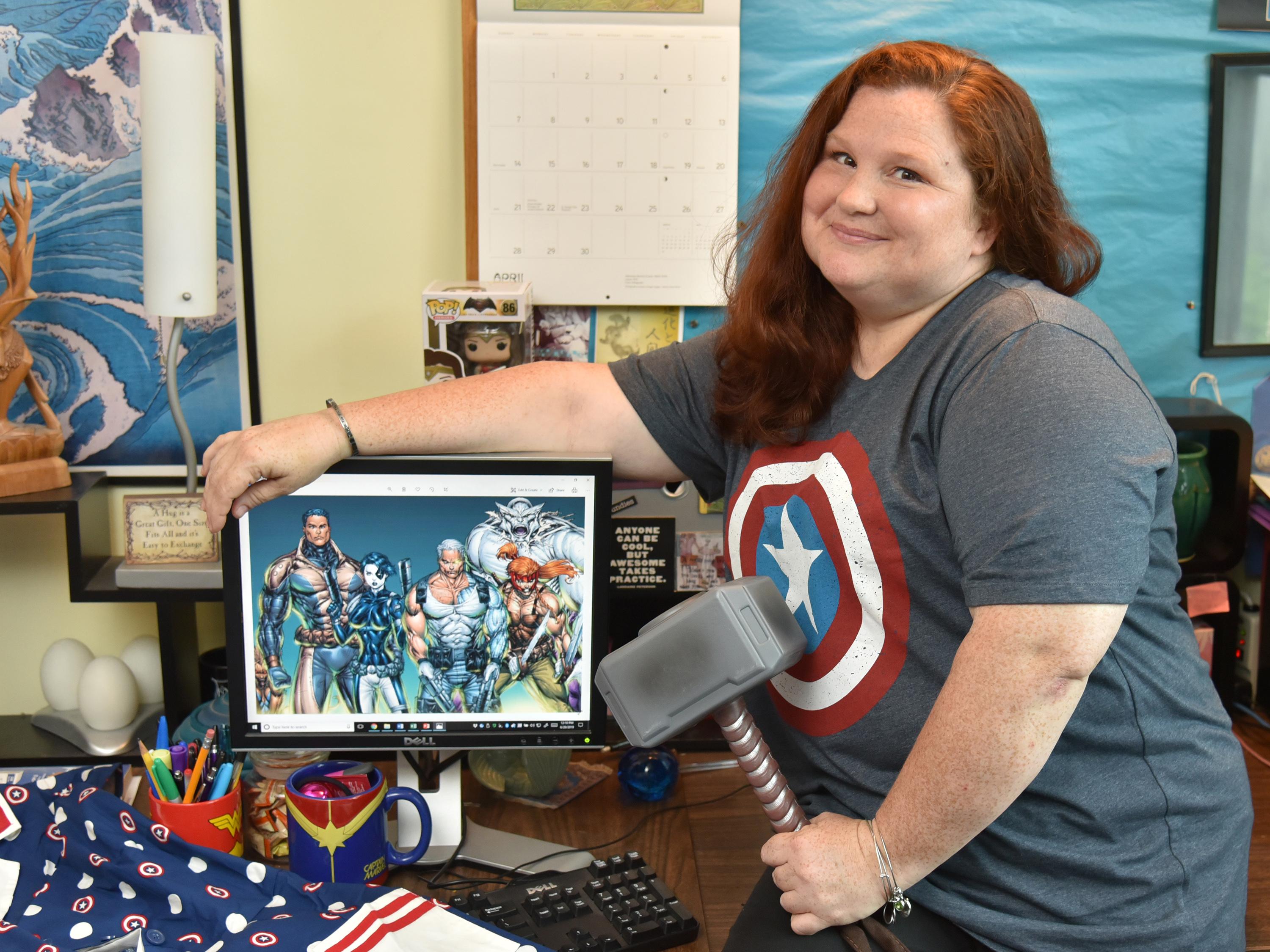Super research -- Research co-authored by Rebecca Burch of Oswego’s human development faculty on superhero appearances recently earned worldwide attention. Burch and Laura Johnsen, a psychology doctoral candidate from Binghamton University, published a study of body mass index for 3,752 Marvel superheroes and villains, which found greatly exaggerated, muscular proportions for males and unrealistically slim, curvaceous forms for females.
The superhero-related work of researchers from SUNY Oswego and Binghamton University picked up international coverage -- with a plot twist.
Rebecca Burch of Oswego’s human development faculty and Laura Johnsen, a psychology doctoral candidate from Binghamton University, collected physical dimensions of 3,752 Marvel superheroes and villains to produce a database on their features and body mass index that found greatly exaggerated, muscular proportions for males and unrealistically slim, curvaceous forms for females.
The article, “Captain Dorito and the Bombshell: Supernormal Stimuli in Comics and Film,” appeared in Evolutionary Behavioral Sciences in April 2019 -- just in time for the opening of the blockbuster “Avengers: Endgame.”
But while news outlets across North America and other continents were quick to write about the results, the research -- much like the motivations of The Incredible Hulk -- was sometimes misunderstood.
The project started with Burch speaking to the NorthEastern Evolutionary Psychology Conference banquet a few years ago. “I encouraged everybody to try something new and branch out of their usual research,” she recalled. “I realized I was going to have to do that, because I asked them to.”
Global reach
For a lifelong fan of comic books and superheroes, Burch said the topic was a labor of love -- and touched upon a franchise that now has an immense global reach.
“Comic book characters, particularly due to their recent cinematic incarnations, can be seen on all forms of media and merchandise,” the researchers wrote, with fan-created art, fiction and memes further permeating pop culture. “These various depictions share the same characteristics, extremely masculinized, muscular men and feminized, curvy women.”
For example, the shoulder-to-waist ratio in the male superheroes was 2.18, while the ratio is 1.12 for the average actual human. The heroes appeared muscular to proportions that approach absurdity -- the average measurements resulted in men with shoulders as wide as they were tall -- particularly in drawn comics, but for a reason. “These are human dimensions that are more than what we see in real life, and that’s what attracts us to it,” Burch explained.
They found female superheroes’ costumes were “more likely to show more skin with cutouts on the arms, thighs, and, in particular, on the chest to show some cleavage.” These women were more curvy, and less likely to appear muscular “with specific accentuation of the waist … to exaggerate these curves,” researchers wrote.
And that is kind of the point, as the researchers characterized supernormal stimuli as “exaggerated versions of stimuli that already elicit responses, so much so that they create a stronger response than the original stimuli.” While movie characters were necessarily not as exaggerated as their comic-book likenesses, Burch and Johnsen factored these together in determining a BMI for their characters.
But the flip side of that is the intentional exclusion and typecasting of characters who do not fit these hyperattractive ideals.
“If you’re female and unattractive, old or overweight, you’re a villain,” Burch said. She did say representation of heroes is improving as the industry embraces a more diverse audience, and that the most notable exception to the rule is rather complicated.
One notable example is the superheroine Big Bertha of the Marvel universe, who can control her body mass index, and swells to her largest form (750 pounds) to wield the greatest power. But even that empowering presentation is somewhat undercut because in the mutant’s everyday disguised form she presents as Ashley, a thin, attractive fashion model (120 pounds). And, to get down to that size, she has to make herself vomit.
The supernormal stimuli of the exaggerated dimensions has found its way into the memes of a knowing audience. The “Captain Dorito” in the journal title refers to a popular meme where fans superimposed a triangular corn chip over a movie still of Chris Evans, portraying Captain America in “The Avengers,” noting the ultrawide shoulders and slim waist. The actors themselves have referenced this meme, which reflects “how viewers and readers have recognized this supernormal stimulus, this exaggeration, and celebrated it,” the researchers noted.
Widespread attention
A recent report from Binghamton University found that the article had been included in numerous publications and websites, such as the Daily Mail, MSN, Yahoo!, Lifestyle, CBS Boston, Inverse.com, ModernHealthCare.com and Pacific Standard, with a total circulation of more than 163.4 million news hits.
Not all of the articles were on target, however. Some used the word “fat,” including it in provocative headlines, when that was not implied by the research -- only body mass, which was generally muscle, Burch said. Others inserted negative implications on the comics industry -- which was not implied and something Burch would disagree with.
As media outlets picked up the story from others, Burch had a feeling some outlets did not read the research. However, she very much appreciates the writers who read the study and followed up with her for some very fruitful conversations and coverage. The Inverse.com article by Sarah Sloat was particularly well done, said Burch, who has used this in comparison to other, less well-written articles in classes to show students how scientific research can be portrayed in the news media.
The research acknowledges some serious issues but notes that the intent of illustrators and directors ultimately is to provide a sense of entertainment and escape.
Burch describes it as “visual cotton candy.” Cotton candy “is something that shouldn’t even be edible, yet we love it,” she explained. “These superheroes don’t look like regular humans, but that’s part of what fans enjoy.”




